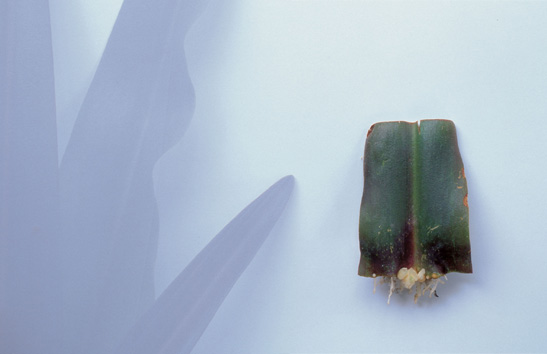
Another miracle of propagation would have to be leaf cuttings. The soft tissues in the leaves of certain herbaceous plants, generally tropical and subtropical species, can grow roots of their own, eventually becoming new plants. The leaves of certain broad-leaved evergreens also have this capacity, as do those of nearly all succulents that have leaves.
There are three types of these specialized cuttings. In two whole leaves or sections of leaves are used. In another, called a leaf-petiole cutting, a leaf along with a bit of its stem is used. With the first two, roots and tiny new shoots grow at the severed leaf veins, and eventually grow into entire plants. In leaf-petiole cuttings, roots form at the base of the cut end of the leaf stem and, later, so does a new plant.
Leaf cutting from hardy broad-leaved evergreens, such as rhododendron and camellia, is a specialized technique, and care for the cutting is exacting, but professionals needing to produce many plants of a rare variety may resort to this microsurgery. In the process, a section of stem is cut between the nodes to include two leaves and leaf buds (if the plant has opposite leaves) or one leaf and bud (if the leaves are alternately arranged). If the stem is sliced in half lengthwise, the cutting with opposite leaves can be cut into even smaller sections.
Usually the plants we choose to make leaf-petiole cuttings from are the softest, tender herbaceous perennials, such as African violets.
A rooted leaf cutting of Eucomis produces one or more bulbs.
The origin of the common name pineapple lily becomes evident upon seeing the floral spike of Eucomis comosa ‘Sparkling Burgundy’ (introduced by Tony Avent of Plant Delights Nuersery) emerging from the silver leaves of tender Plectranthus argentatus.

More unusual cuttings can be made from another member of the African violet, or gesneriad, family. The Cape primrose (Streptocarpus hybrids) leaf can be cut into pieces to root. Select a young leaf that is fully enlarged. Place the leaf upside down on a sheet of glass, and slice away the midrib of the leaf with a sharp blade —either a fresh single-edged razor blade or a sharp knife dipped in rubbing alcohol and blotted on a paper towel. (Be sure to sterilize the blade before working on any plant.) The Cape primrose leaf can also be cut into 2-inch-long, crosscut sections. It is important to note the top or tip end of the leaf because the bottom or stem end must be set in the medium —cuttings set with the tip end in the medium will not root. Set the cut parts shallowly in the medium and lean cross-cut sections to expose their upper surface. The number of new plants that can be produced is staggering. One leaf may yield a hundred or more babies.
Once leaf cuttings have roots, whether visible on the surface of the medium or detected by prying a sample out of the medium, the young plants can be moved to individual pots. The microscopic Streptocarpus babies are harder to handle. Unless they are taken off the leaves early, some of the tiny plants may be lost. The small plants can be pulled free with a tweezers and reset in the medium to grow until large enough to transplant to pots. The young Cape primroses in the medium should be watered with a mild water-soluble plant food, perhaps a 10-10-10 at half strength.
Rex begonias (Begonia rex) can produce many offspring from one leaf. Turn the leaf upside down on a pane of glass, and make a short slice through each of the thick veins. Then place the leaf right side up on moist medium, and pin it in place with hairpins or U-shaped loops made of bent copper wire; new plants will emerge at the cuts.
Logee’s Greenhouses in Danielson, Connec-ticut—a century-old establishment specializing in begonias and other indoor plants —employs a method that produces several salable plants from single Begonia rex leaves by using leaf-wedge cuttings. The growers remove a leaf, turn it over, and slice it into wedges so that the pointed ends come from the bottom part and include a piece of a large vein. They dip the wedge point in a mild solution of a liquid hormone before placing it about 1 inch deep in their chosen medium —moist, coarse sand. In about six months, four to six new plants can be removed and potted.
An extreme variation on the Rex begonia leaf cutting calls for tiny squares cut out of leaves. The leaves are turned upside down on a pane of glass and cut into 1-inch squares. Edges with a cut vein are inserted into the medium to about a third of their height. Only one or two plants will grow from each square, but dozens of cuttings can be made from each leaf. The rooted cuttings are potted like those of African violets.
Leaf cuttings yielded thirty one-year-old Eucomis plants for a fund-raising event.
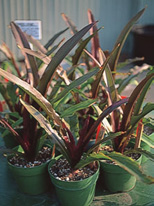
The one-year-old result of an African violet leaf cutting. Success leads to a lust for more, and amassing a sizable collection is easy by trading leaves with friends. Of course, plants grown from patented hybrids, marked on the label, must not be propagated for sale while the patent is in effect. However, check closely for the more common “TM,” which merely trademarks the name or label design of a purchased plant.
One more type of Rex begonia cutting is the “leaf wedge.” Sections are cut into fan shapes with large veins at the point that will be stuck in medium and from which hefty roots and plants will grow.
There are two ways to make the cuts from the Cape primrose, beginning with a young but full-grown leaf. A pane of glass can be used for a supersmooth cutting surface (1). Place the leaf on the glass (or similar surface) and cut it horizontally into sections with a very sharp blade, remembering to keep track of the orientation (2). The other method begins with a turned-over leaf from which the central vein is removed (3). Next, make a groove in moistened, sterile rooting medium, insert the cut surfaces (retain polarity for the slices), and lean the cuttings so the undersides of the leaves face the medium (4). The cuttings need high humidity from a plastic dome over a flat or a sweatbox, and gentle heat supplied by an electric heat mat from below (5). Hundreds of baby plants will grow along the edge of the leaf-blade cutting (6).
Leaf cuttings can be made from many gesneriads, such as this Cape primrose (Streptocarpus hybrid), as well as the African violet.
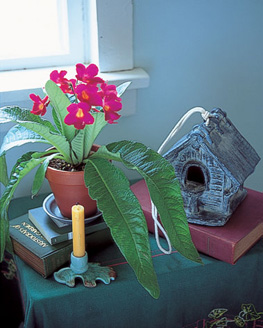
Slice and dice: Rex begonias are propagated from cuttings of various sizes. In every case, a cut vein will go into the medium and that is where roots and then new plants will grow. Assemble: A leaf (‘Fire Flush’), razor blade, hairpins, pane of glass to cut on, and straightedge. For a whole-leaf cutting, turn the leaf over on the glass and make short incisions across the major veins (1). Place the leaf on rooting medium and push hairpins through the leaf, straddling the veins between the cuts (2). Roots will grow, then plants (3, 4). Another leaf (‘Iron Cross’) is readied for a checkerboard treatment (5). Press the leaf down with the straightedge and cut across the veins (6). Turn the straightedge 90 degrees and continue (7) until 1-inch squares are made (8). Set them with their largest veins in medium to grow roots and plantlets (9).
Leaves from monocots, such as ones in the lily family, including the snake plant (Sansevieria trifasciata), can be cut and rooted, but polarity must be retained, so arrows are drawn on cuttings with permanent marker. The leaves of many succulents will root at the petiole end: Jade plants (Crassula argentea cvs.) drop their fleshy leaves; roots grow, and developing plants absorb the moisture from the old leaves.
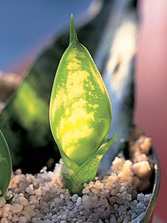
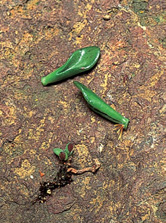
A compound leaf of the aquatic umbrella palm (Cyperus alternifolius) roots in nature when a leaf stalk bends to touch the water, or when you cut off the whorl of leaves with a 1-inch-long stalk. Trim the leaf tips if they are frayed. Then the stalk is pushed into moist medium up to its leaves, which is where roots and shoots will grow, as can be seen with the nearby miniature papyrus (Cyperus profiler).
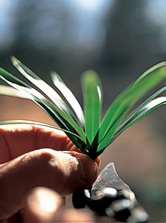
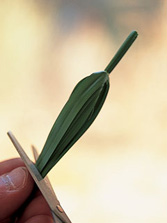
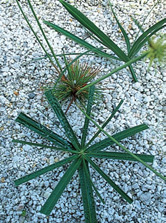
The leaves we’ve been using for cuttings so far have been from dicotyledons with a branching network of veins. Now, monocotyledons, which have parallel leaf veins, are the subjects. Many rushes, such as papyrus (Cyperus), will supply leaf-petiole cuttings, and some lily family members provide material for making transverse sections of vertical leaves to root.
The lily family is among the largest in the plant kingdom: Asparagus spears are distant cousins of the onion bulbs; giant 10-foot-tall yucca plants are related to tiny snow drops. Plants you might consider trying include hardy hyacinth, tender Lachenalia, pineapple lily (Eucomis), and snake plant (Sansevieria).
But do not expect to pass on the lovely variegation of a particular snake plant cultivar through leaf cuttings. This anomaly is one exception to the rule that vegetative propagation always produces clones; the chimera that create the variegation are located in the meristem, or growing cells at the plant’s growing point, which for Sansevieria is the underground stem or rhizome’s terminal end. The leaf cutting makes a new rhizome, which is a reproduction of the original species without the variety’s characteristics. A snake plant with variegation can only be started from a division of its rhizome (see here) that includes the or meristem growth.
There are many species of Sansevieria, however, and using leaf cuttings is a great way to make more of those. The procedure for taking leaf cuttings of monocots is similar to that for taking leaf sections of Cape primrose (see here). Polarity is essential; the cutting will not grow roots in the medium if set upside down (if the atmosphere is humid enough, roots will actually grow into the air if the cutting is stuck wrong side up). Use a waterproof felt-tipped pen and mark little arrows on the leaves.